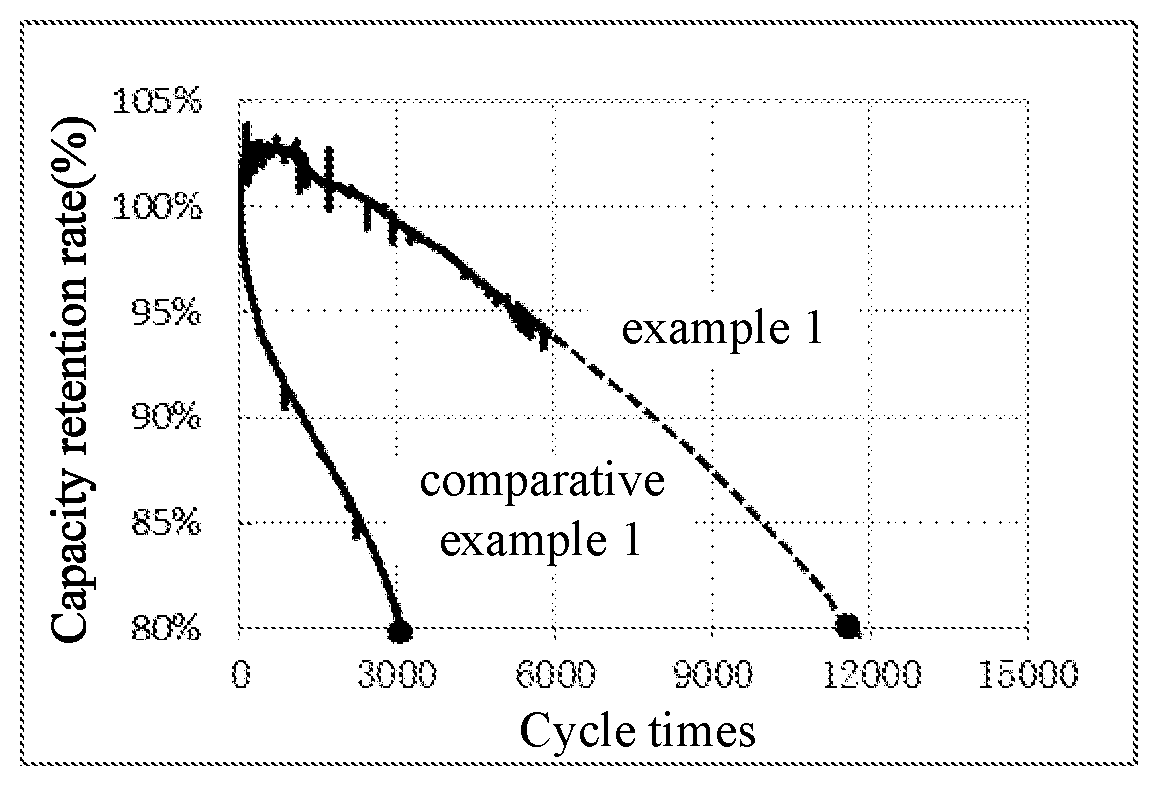Lithium-ion battery
a lithium-ion battery and lithium-ion technology, applied in secondary cell servicing/maintenance, cell components, electrochemical generators, etc., can solve the problems of reducing the discharge voltage platform, affecting and inevitably affecting the capacity of lithium-ion batteries, so as to prolong the cycle life and storage life of lithium-ion batteries. the effect of stability and stability of the negative electrode pla
- Summary
- Abstract
- Description
- Claims
- Application Information
AI Technical Summary
Benefits of technology
Problems solved by technology
Method used
Image
Examples
example 1
[0052](1) Preparation of a Positive Electrode Plate
[0053]Lithium iron phosphate (positive electrode active material, the gram capacity was 139 mAh / g), acetylene black (conductive agent), PVDF (binder) at a mass ratio of 94:4:2 were uniformly mixed with N-methylpyrrolidone (NMP, solvent), and a positive electrode slurry was obtained, then the positive electrode slurry was uniformly coated on two surfaces of an aluminum foil (positive electrode collector), and the positive electrode plate was obtained after drying and cold-pressing. Where, the coating mass of the positive electrode slurry was 0.198 g / 1540.25 mm2 (the coating mass was based on the mass of the solid component without the solvent).
[0054](2) Preparation of a Negative Electrode Plate
[0055]Artificial graphite (negative electrode active material, the gram capacity was 340 mAh / g), acetylene black (conductive agent), SBR (a binder) and CMC at a mass ratio of 95:1.5:3.1:0.4 were uniformly mixed with deionized water (solvent) an...
example 2
[0064]The preparation of the lithium-ion battery was the same as example 1, except that in the preparation of an electrolyte (step (3)), in an argon atmosphere glove box with a water content 6 (lithium salt) was dissolved in the above organic solvent and stirred uniformly, an electrolyte was obtained, where, the concentration of the LiPF6 was 1 mol / L.
example 3
[0065]The preparation of the lithium-ion battery was the same as example 1, except that in the preparation of an electrolyte (step (3)), in an argon atmosphere glove box with a water content 6 (lithium salt) was dissolved in the above organic solvent and stirred uniformly, an electrolyte was obtained, where, the concentration of the LiPF6 was 1 mol / L.
PUM
| Property | Measurement | Unit |
|---|---|---|
| conductivity | aaaaa | aaaaa |
| conductivity | aaaaa | aaaaa |
| size | aaaaa | aaaaa |
Abstract
Description
Claims
Application Information
 Login to View More
Login to View More - R&D
- Intellectual Property
- Life Sciences
- Materials
- Tech Scout
- Unparalleled Data Quality
- Higher Quality Content
- 60% Fewer Hallucinations
Browse by: Latest US Patents, China's latest patents, Technical Efficacy Thesaurus, Application Domain, Technology Topic, Popular Technical Reports.
© 2025 PatSnap. All rights reserved.Legal|Privacy policy|Modern Slavery Act Transparency Statement|Sitemap|About US| Contact US: help@patsnap.com

